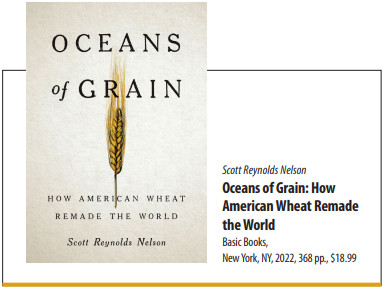Oceans of Grain: How American Wheat Remade the World

This persuasive argument that wheat plays a key role in the rise and fall of empires was published two days before Russia’s invasion of Ukraine sent prices for the grain soaring to a record and stirred supply fears.
War and hunger are key themes throughout Scott Reynolds Nelson’s history of how wheat feeds the world. From Nelson’s first research visit to Odesa in 2011, just as bread riots sparked the Arab Spring that toppled governments from Tunisia to Egypt, he pivots back 12,000 years to the genesis of Europe’s breadbasket, in what are now Ukraine and Russia, and the ancient grain trade routes that later fed the continent’s cities and armies.
Dense with history, politics, economics, the University of Georgia humanities professor’s fifth book still remains light and engaging as it cycles through centuries of grain. Its storage and shipment weave through Athens and Constantinople and Moscow, and the founding of the Black Sea port of Odesa, with ties to other milestones, like the first quarantines and the creation of hamburgers and commercial investment banking.
This trade concentrates labor and capital in cities where food is cheap and ports are deep. Immigration, industrialization, and urbanization follow, doubling the residents of London, Paris, and Amsterdam in 1845–60. The United States rises in the 1860s, when the Civil War spurs the embrace of wheat exports to gain needed foreign exchange to fight secession, and the Union Army’s struggle to feed soldiers and horses helps birth modern futures markets on the Chicago Board of Trade.
These new financial tools help create a more global food market just as US shipments boom, with thousands of ships flooding Europe with grain and bearing millions of immigrants back across the Atlantic. Meanwhile, faster travel between the world’s ports, shortened by explosives used to deepen harbors and carve canals and railroads, helps end Russia’s sway over global grain by giving Europe’s cities cheaper food. Nelson further argues that most scholars don’t recognize how much the rise of Germany and Italy, the decline of Austria and Turkey, and Europe’s scramble for empire all really have to do with inexpensive foreign grain.
The book is a financial history, and the best passages chronicle international commodity markets bound increasingly together by wheat. Nelson, who notes on page 1 his obsession with the Panic of 1873, traces that agrarian crisis turned financial panic and economic slump from falling food prices and outmoded financial tools to European bank failures, a Bank of England interest rate shock, and a crisis reaching Wall Street.
“Oceans of grain had flooded Europe, and the flush times in Odessa and much of central Europe had ended, sending shockwaves around the world,” Nelson writes.
The story concludes a century ago, in the aftermath of Russia’s revolution, but still feels comprehensively modern as it pushes readers to think more like grain traders, and to see the world not as clearly mapped nations but rather the crucial journeys of our food across oceans, rivers, and ports that really write history.
Opinions expressed in articles and other materials are those of the authors; they do not necessarily reflect IMF policy.








